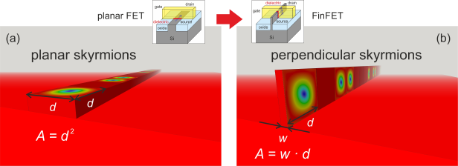Scientists from ShanghaiTech University, Diamond Light Source, the SOLEIL synchrotron and University of Oxford report in a recent issue of Nano Letters on their discovery of a novel skyrmion surface state that exists in applied in-plane fields – much different from the usual out-of-plane geometry. In this geometry, magnetic signals from the skyrmion lattice phase settle down in inconvenient reciprocal space locations, making resonant elastic X-ray scattering (REXS) on the chiral magnet Cu2OSeO3 a challenging job to carry out. By combining the complementary capabilities of the soft X-ray diffractometers at two synchrotrons (Diamond and SOLEIL) on the very same sample, the new state was unambiguously identified.
The search for improved information carriers remains a major task in data storage technology research. The ideal candidate should be stable against external disturbance such as temperature or field fluctuations, it should allow for low-power manipulation and easy readout, combined with a small footprint allowing for high packing densities. In principle, magnetic skyrmions fit the requirements well and are therefore undergoing a data storage health check. Their key advantage arises from their topological properties: its particular magnetic moment configuration, i.e., the self-protected vortex shape, is robust against certain distortions. Their topology also induces novel magnetoelectrical effects, allowing for efficient manipulation and detection.

In principle, the most straightforward way of making use of skyrmions for memory devices is to assign a logic 0 or 1 to the absence or presence of a skyrmion in a magnetic racetrack memory scheme. Many of the components needed for an experimental realization of this technology have recently been reported in the literature. Nevertheless, two key issues remain challenging. First, skyrmions have to be tamed to keep their distance when being moved along the racetrack, i.e., the encoded information has to be preserved. Second, the storage density in this conventional racetrack design is governed by the skyrmion diameter, as shown in Fig. 1(a). In analogy to the introduction of perpendicular memory, an improved version of a racetrack can be achieved by erecting the bits as shown in Fig. 1(b) – a `perpendicular skyrmion array’. In this case, the storage density is merely governed by the skyrmion depth itself, as the thickness of a skyrmion is theoretically vanishing due to its two-dimensional nature!
When carrying out their REXS study in the in-plane geometry on the well-known skyrmion crystal Cu2OSeO3, the research team was surprised by the emergence of an exotic surface skyrmion lattice state. First, the skyrmion array survives at very low temperatures, much different from the known, tiny skyrmion pocket in out-of-plane fields. In fact, at low temperatures, skyrmions only ‘float’ at the very surface of the bulk sample, above a sea of conical spirals. The thickness of this surface state is estimated to be only 120 nanometers. Second, by applying an oblique magnetic field, the team showed that the surface skyrmion array is strongly ‘pinned’ to the surface, resisting the field tilting.
Lead author Prof Shilei Zhang clarifies:
The discovery of surface pinned skyrmions has important implications for technological applications of magnetic skyrmions. First, as the surface provides an attractive potential for the skyrmions, the engineering of surfaces and interfaces allows for the precise tuning of skyrmion properties. Further, the robustness of surface skyrmions against temperature and magnetic field variations makes them ideal candidates for magnetic bits. Finally, the ability to go ‘perpendicular’ will enable new design concepts for skyrmion memory.
For more information on the subject matter, please contact either Professor Shilei Zhang (ShanghaiTech University): [email protected], Professor Gerrit van der Laan (Diamond): [email protected], or Professor Thorsten Hesjedal (Oxford Physics): [email protected].
To find out more about the I10 beamline, or to discuss potential applications, please contact Principal Beamline Scientist Paul Steadman: [email protected].
Shilei Zhang, David M. Burn, Nicolas Jaouen, Jean-Yves Chauleau, Amir A. Haghighirad, Yizhou Liu, Weiwei Wang, Gerrit van der Laan, and Thorsten Hesjedal, Robust Perpendicular Skyrmions and Their Surface. Nano Letters (2020). DOI: https://doi.org/10.1021/acs.nanolett.9b05141
Diamond Light Source is the UK's national synchrotron science facility, located at the Harwell Science and Innovation Campus in Oxfordshire.
Copyright © 2022 Diamond Light Source
Diamond Light Source Ltd
Diamond House
Harwell Science & Innovation Campus
Didcot
Oxfordshire
OX11 0DE
Diamond Light Source® and the Diamond logo are registered trademarks of Diamond Light Source Ltd
Registered in England and Wales at Diamond House, Harwell Science and Innovation Campus, Didcot, Oxfordshire, OX11 0DE, United Kingdom. Company number: 4375679. VAT number: 287 461 957. Economic Operators Registration and Identification (EORI) number: GB287461957003.